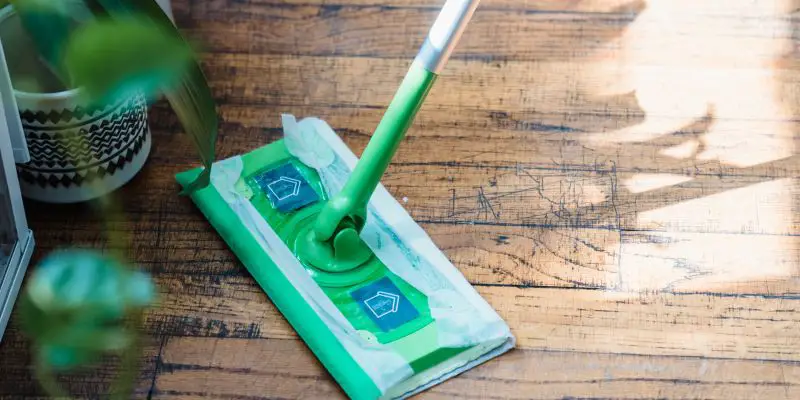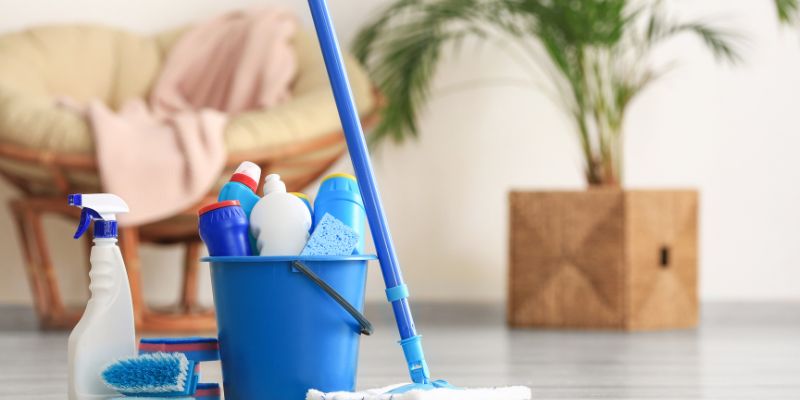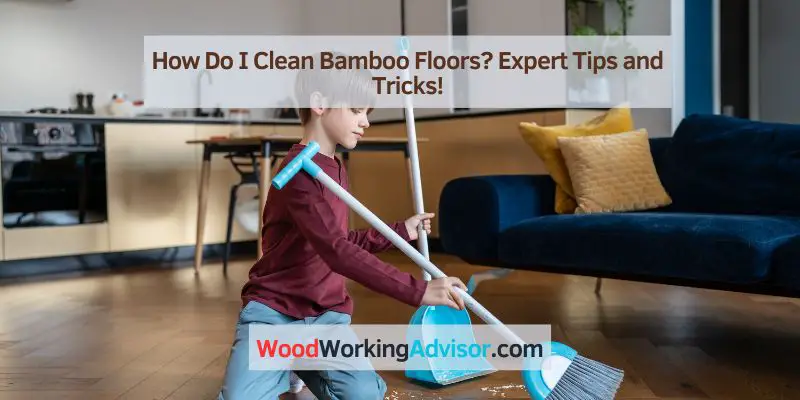To clean bamboo floors, sweep or vacuum regularly to remove dirt and debris, then use a damp mop with a pH-neutral cleaner specifically formulated for bamboo flooring. Bamboo floors are an eco-friendly and attractive option for many homeowners.
However, proper maintenance and cleaning are essential to keep them looking their best. Regular sweeping or vacuuming is necessary to remove dirt and dust that can scratch the surface. Additionally, using a damp mop with a pH-neutral cleaner specially designed for bamboo floors will help to remove any stubborn stains or spills.
By following these simple steps, you can maintain the beauty of your bamboo floors for years to come.
Understanding Bamboo Floors
Bamboo floors are becoming increasingly popular due to their durability, sustainability, and distinct beauty. However, maintaining the pristine condition of bamboo flooring can be a challenge if not properly cared for. To help you keep your bamboo floors clean and looking their best, it is essential to understand the composition and characteristics of bamboo flooring, as well as the different types available.

Composition And Characteristics
Bamboo flooring is made from the matured stalks of the bamboo plant, which are harvested and processed to create versatile flooring options. This composition gives bamboo floors their unique strength and durability. Here are some key characteristics of bamboo floors:
- Bamboo floors are known for their exceptional hardness, making them highly resistant to scratches and dents.
- They have a natural resistance to moisture, making them an ideal choice for areas prone to humidity and moisture, such as kitchens and bathrooms.
- Bamboo flooring is eco-friendly and sustainable, as bamboo is a rapidly renewable resource that can be harvested without causing damage to the plant or its surrounding environment.
Types Of Bamboo Floors
There are different types of bamboo flooring available, each offering unique features and styles. The main types of bamboo floors include:
| Type | Description |
|---|---|
| Vertical Bamboo | Consists of narrow bamboo strips arranged vertically, presenting a striped appearance. |
| Horizontal Bamboo | Features wider bamboo strips arranged horizontally, offering a more natural look with visible knuckles. |
| Strand-woven Bamboo | Created by compressing shredded bamboo fibers under extreme pressure, resulting in a highly durable and dense flooring option. |
- Engineered Bamboo: Combines a bamboo wear layer with a plywood or high-density fiberboard (HDF) core, providing enhanced stability and resistance to moisture.
Understanding the composition and characteristics of bamboo floors, as well as the different types available, is crucial for effective cleaning and maintenance. By selecting the right cleaning methods and products specific to your bamboo flooring type, you can ensure its longevity while enjoying its natural beauty.
Cleaning And Maintenance
Cleaning and proper maintenance are essential for preserving the beauty and longevity of your bamboo floors. With the right techniques and regular care, you can keep your floors looking clean and pristine for years to come. In this section, we will guide you through the step-by-step process of how to clean bamboo floors effectively.
Regular Sweeping And Dusting
To keep your bamboo floors free from dirt, dust, and debris, regular sweeping and dusting are crucial. By incorporating these simple cleaning routines into your schedule, you can prevent scratching and maintain the pristine appearance of the bamboo.
In rooms with heavy foot traffic, it is advisable to sweep your bamboo floors daily. Use a soft-bristle broom or a microfiber dust mop to gently remove any dirt or debris. Start from one end of the room and work your way towards the exit, ensuring that you cover the entire floor surface.
Proper Mopping Technique
Avoid using excessive water when mopping bamboo floors, as it can seep into the seams and potentially cause damage. Instead, opt for a damp mop and a pH-neutral bamboo floor cleaner. These cleaners are specifically formulated to remove dirt and grime without leaving any residue or causing discoloration.
Begin by thoroughly wringing out the mop to ensure it is only slightly damp. Working in small sections, gently mop the floor using a back-and-forth motion, following the direction of the bamboo planks. Be sure to overlap each stroke to ensure complete coverage. Rinse the mop frequently to avoid spreading dirt or debris across the floor.
Dealing With Stains
Accidents happen, and sometimes stains may appear on your bamboo floors. It’s important to address stains promptly to prevent them from setting in and becoming more difficult to remove.
Avoid using harsh or abrasive cleaners, as they can damage the bamboo finish. Instead, start by blotting the stain with a soft cloth or paper towel to absorb any liquid. Then, using a slightly damp cloth, gently rub the stain in a circular motion. If the stain persists, consult the manufacturer’s guidelines or seek professional advice on suitable stain removal methods.
Preventing Scratches
Preventing scratches on your bamboo floors is essential to maintain their pristine appearance. Incorporate these simple preventative measures into your daily routine to protect your floors:
- Place floor mats or rugs at entrances to trap dirt and debris.
- Use furniture pads or felt bottoms on chair legs, table legs, and other furniture to prevent scratches when moving them.
- Avoid wearing shoes with sharp heels or hard soles on the bamboo floors.
- Regularly trim pet nails to prevent scratches from pet movements.
Maintaining The Shine
To maintain the natural shine of your bamboo floors, follow these tips:
- Limit direct exposure to sunlight by using curtains or blinds.
- Wipe up spills immediately to prevent water damage or staining.
- Periodically apply a bamboo floor polish or wax to restore the shine.
- Follow the manufacturer’s guidelines for recommended products and application methods.
By following these cleaning and maintenance practices, you can ensure that your bamboo floors remain clean, beautiful, and long-lasting for years to come.

Natural Cleaning Solutions For Bamboo Floors
Bamboo floors add a touch of elegance and natural beauty to any home, but keeping them clean and well-maintained is essential to preserving their beauty for years to come. Natural cleaning solutions are not only effective in removing dirt and grime, but they are also safe for the environment and your family. Here are three natural cleaning solutions that will help you keep your bamboo floors spotless:
Vinegar And Water Solution
Mixing vinegar and water is a simple yet effective way to clean and disinfect your bamboo floors. This solution is gentle enough to use regularly and won’t leave behind a sticky residue. To create this cleaning solution, simply combine equal parts white vinegar and warm water in a spray bottle.
Steps to clean your bamboo floors with vinegar and water solution:
- Sweep or vacuum the floor to remove any loose dirt and debris.
- Spray the vinegar and water solution onto a microfiber mop or cloth.
- Gently mop the bamboo floor, working in small sections.
- Allow the floor to air dry or use a clean, dry cloth to remove any excess moisture.
This natural cleaning solution not only cleans your bamboo floors but also helps to restore their natural shine.
Baking Soda Paste
If your bamboo floors have tough stains or scuff marks, a baking soda paste can come to the rescue. Baking soda is a natural abrasive that can help remove stubborn stains without damaging the floor. To make a baking soda paste, mix three parts baking soda with one part water until it forms a thick consistency.
Steps to clean your bamboo floors with a baking soda paste:
- Apply the baking soda paste directly to the stain or scuff mark.
- Gently rub the paste in a circular motion using a soft cloth or sponge.
- Rinse the area with clean water and dry it thoroughly.
The baking soda paste is a natural and effective solution for deep cleaning your bamboo floors and restoring their original beauty.
Lemon Juice And Olive Oil Mixture
A mixture of lemon juice and olive oil can serve as a natural cleaner and conditioner for your bamboo floors. Lemon juice acts as a natural cleanser, while olive oil helps nourish and protect the bamboo. To create this mixture, combine half a cup of lemon juice with one cup of olive oil.
Steps to clean your bamboo floors with a lemon juice and olive oil mixture:
- Dip a soft cloth or mop into the lemon juice and olive oil mixture.
- Gently wring out any excess liquid.
- Wipe the bamboo floor, ensuring even coverage.
- Allow the floor to air dry, enhancing its natural shine.
This natural solution not only cleans your bamboo floors but also leaves them looking refreshed and rejuvenated.
Dos And Don’ts For Bamboo Floor Cleaning
Discover the essential dos and don’ts for effectively cleaning bamboo floors. Learn how to maintain the beauty and durability of your bamboo flooring with these expert tips.
Recommended Practices
Bamboo floors are a popular and eco-friendly choice for many homeowners. To ensure your bamboo floors stay clean and maintain their natural beauty, it’s important to follow the recommended practices. Here are some dos to keep in mind:
- Sweep or vacuum regularly: Regular sweeping or vacuuming with a soft brush attachment helps prevent dirt and dust from accumulating on your bamboo floors.
- Use a damp mop: When it’s time for deeper cleaning, a damp mop can do wonders. Make sure to wring out the mop thoroughly so that it’s only damp and not soaking wet.
- Use mild cleaning agents: To maintain the integrity of your bamboo floors, opt for mild cleaning agents specifically formulated for use on wood surfaces. Harsh chemicals can damage the bamboo and strip away its protective finish.
- Wipe spills immediately: Accidents happen, but when it comes to bamboo floors, it’s important to act fast. Wipe up any spills immediately to prevent moisture from seeping into the bamboo and causing damage.
- Protect your floors: Place doormats at entrances to trap dirt and prevent it from being carried onto your bamboo floors. Additionally, consider using furniture pads under the legs of your furniture to avoid scratches.
Things To Avoid
While there are recommended practices for bamboo floor cleaning, there are also some things you should avoid to protect the beauty and longevity of your floors. Here are some don’ts to keep in mind:
- Avoid excessive moisture: Bamboo is sensitive to moisture, so avoid using excessive amounts of water when cleaning your floors. Excess moisture can cause the bamboo to warp or swell.
- Avoid harsh cleaning agents: Stay away from abrasive and acidic cleaning agents that can damage the bamboo’s natural shine. Stick to mild cleaning solutions to protect the bamboo’s finish.
- Don’t use steam cleaners: While steam cleaners may be suitable for other types of flooring, they should not be used on bamboo floors. The intense heat and moisture from steam cleaners can cause irreparable damage to the bamboo.
- Avoid dragging heavy furniture: When rearranging furniture, lift it instead of dragging it across the floor. Dragging heavy furniture can scratch and dent the bamboo.
- Don’t use wax or polish: Unlike some other types of flooring, bamboo does not require waxing or polishing. These products can leave a film on the surface of the bamboo, dulling its natural luster.
Conclusion
To effectively clean bamboo floors, it is essential to follow the right techniques and use suitable products. Regular sweeping and gentle mopping with a damp cloth are key to maintaining their shine and longevity. Avoid wax-based cleaners or excessive water, as they can damage the flooring.
Instead, choose non-abrasive cleaning solutions specifically designed for bamboo floors. By implementing these practices, you can ensure that your bamboo floors stay clean, impressive, and durable for years to come.


